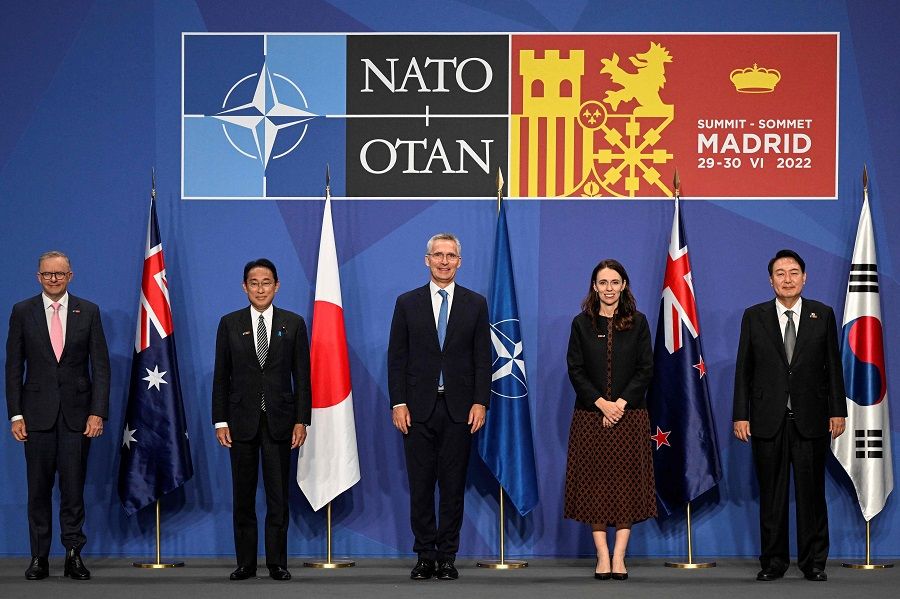What a 'resurrected' NATO means for China and the world

Once described as "brain dead", the North Atlantic Treaty Organization (NATO) recently held a leaders' summit of a weight and influence not seen in a long time. Several news reports have already been written about the meeting, but some warning signals given at the summit warrant further analysis.
The leaders of NATO, the world's strongest military alliance of 30 European and North American countries, met in Madrid on 29 June. Unsurprisingly, they condemned Russia's invasion of Ukraine and referred to Russia as the "most significant and direct threat" to peace and stability in the Euro-Atlantic area. More noteworthy is the fact that the leaders endorsed a new Strategic Concept that cites for the first time the "systemic challenges" posed by China.
... the term "systemic challenges" is now written into NATO's weightier Strategic Concept. In addition, NATO is using stronger language on China.
Granted, this is not the first time that China is mentioned in a NATO document. In a communique issued last June, NATO leaders criticised China's "stated ambitions and assertive behaviour" as presenting "systemic challenges to the rules-based international order and to areas relevant to Alliance security". But, the term "systemic challenges" is now written into NATO's weightier Strategic Concept. In addition, NATO is using stronger language on China.
Framing a picture of China
NATO's Strategic Concept is a document that outlines NATO's priorities for the next ten years. In its 2010 edition, China was not mentioned and Russia was even called "a partner". This year's version has 49 paragraphs, of which China is mentioned in paragraphs 13 and 14, where its "stated ambitions and coercive policies" (the June 2021 communique mentioned "assertive behaviour") are said to challenge NATO's "interests, security and values".
The document also accuses China of "remaining opaque about its strategy, intentions and military build-up" despite using a series of "political, economic and military tools to increase its global footprint and project power"; spreading "disinformation"; seeking to "control key technological and industrial sectors, critical infrastructure, and strategic materials and supply chains"; using "its economic leverage to create strategic dependencies and enhance its influence"; and striving to "subvert the rules-based international order, including in the space, cyber and maritime domains".

The document also mentions China and Russia's "deepening strategic partnership" and their "mutually reinforcing attempts to undercut the rules-based international order". NATO Secretary General Jens Stoltenberg even said at a press conference that China is "bullying its neighbours, and threatening Taiwan" and "monitoring and controlling its own citizens through advanced technology".
... as Japan, South Korea, Australia and New Zealand grow closer to NATO, they too, will keep China in check in the region.
Strategic implications for China from Russia-Ukraine war
These statements show that Russia's invasion of Ukraine has brought about numerous adverse strategic implications for China. In particular, the US has successfully tied China and Russia together, which has helped it corral an international alliance against China while internationalising the Taiwan issue.
NATO, once declared "brain dead" by French President Emmanuel Macron, is now "fully resurrected", as the internet lingo goes. Just before the release of the new Strategic Concept, NATO formally invited two European military powers, Finland and Sweden, to join the military alliance, paving the way for NATO's largest expansion in a decade.
Not only that, it seems that apart from its eastward expansion, NATO is keen on an "Asian expansion" as well. The leaders of the four Asia-Pacific countries of Japan, South Korea, Australia and New Zealand were invited to the summit in Madrid for the first time. In a report by the NATO 2030 Young Leaders Group last year, these four countries were already listed as NATO's key partners in the Asia-Pacific region.
... when the US is ready to contain China, the fact that Japan, South Korea and the EU will be standing with the US is a reality that is hard to reverse.

Prior to the outbreak of the Ukraine war, academics and the media have already been asking if the Quadrilateral Security Dialogue (Quad) strengthened by the US would grow into an "Asian NATO". Now that India looks set on maintaining its policy of non-alignment as well as its ties with Russia, that prospect is looking less likely. But as Japan, South Korea, Australia and New Zealand grow closer to NATO, they too, will keep China in check in the region.
Hard facts for China
How will China evaluate the impact of the NATO summit? While Stoltenberg emphasised on 29 June that China poses "serious challenges", he also said that China "is not an adversary". Although it seems that there are divisions in NATO on the approach to China, with France and Germany urging caution and restraint in light of their investments in China, NATO's anti-China stance is clear to China, or perhaps it is even within China's calculations.
The endorsement of the Strategic Concept and the participation of the leaders of Japan, South Korea, Australia and New Zealand at the summit are clear signals to China that when the US is ready to contain China, the fact that Japan, South Korea and the EU will be standing with the US is a reality that is hard to reverse. Although China once tried to win the EU over through economic and trade relations or strategic collaboration, the fact is that this would be difficult to achieve because of the different values that China and Europe hold.
If China and the US fall into a struggle between two opposing camps, the world would descend into bifurcated chaos, hurting everyone in the process.

At present, NATO's Strategic Concept document only talks about the "systemic challenges" China presents in terms of politics and values, with no substantial follow-up actions yet. However, this definition is just a start - if rivalry between both sides extends to economic and trade relations, say, the US pushes for supply chain decoupling, it is highly likely that the EU will stand on the US's side even if it means suffering huge economic losses.
While the prospects of these eventualities may weaken China's strategic position, they are not just China's problem to deal with. If China and the US fall into a struggle between two opposing camps, the world would descend into bifurcated chaos, hurting everyone in the process. Undoubtedly, these are just concerns at the back of the mind for now. China and the US still have much to gain from working together and both sides are seeking to ensure that "guardrails" are in place as well. But the escalating and widening scope of confrontation makes one worry that reason will not necessarily prevail.
Related: China at the centre of the world's politics | US sets up strategic obstacles against 'autocratic' China | Framing China's actions: From 'assertive' to 'aggressive' | Shangri-La Dialogue 2022: A tougher diplomatic battle for China? | Competition between democracy and autocracy a political fallacy
